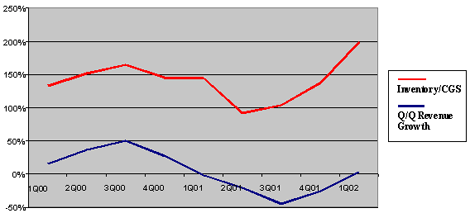Who'll survive in optical components? Which products are likely to recover first? Optical Oracle answers all
June 27, 2002

Excess inventory, slow sales, and pricing pressures helped put optical component vendors behind the eight ball this year. Now the inevitable consolidation has just begun, and the question being asked is, how far away are we from recovery?
That’s the key question addressed by "Components Crunch Time," the latest report from Optical Oracle, Light Reading's paid subscription service. By reviewing the state of public and private companies in the sector and identifying key trends, the report sizes up the situation and maps out the likely progress of recovery.
In short, the answer is: We're many months, if not years, away from the return to a healthy components industry.
Progress won’t come easy. Propelled by generous amounts of funding back in the boom times of 2000 and early 2001, startups flooded the components sector with products. More than a year after the inventory correction began in earnest, the industry is still saddled with too many suppliers and too few buyers.
What’s more, recent activity shows that companies are still plagued by bulging inventories and sluggish sales. Indeed, inventory is still rising in relation to the amount of product companies are selling, or cost of goods sold -- the exact opposite of what needs to happen.  Given this state of affairs, companies in the sector are faced with the choice to merge or get bought by larger players -- or face almost certain demise. Going forward, the number of vendors will be whittled down dramatically, and while some will be acquired, literally hundreds will simply go out of business.
Given this state of affairs, companies in the sector are faced with the choice to merge or get bought by larger players -- or face almost certain demise. Going forward, the number of vendors will be whittled down dramatically, and while some will be acquired, literally hundreds will simply go out of business.
Companies that do survive will be those that gain extra capabilities through mergers and acquisitions. They’ll be the ones to develop a wider range of components, so that systems vendors can find everything they need off the shelf, from as few suppliers as possible.
So who will survive? The report analyzes the financials, inventory, liquidity, and overall prospects of the leading public companies in the sector:
Agere Systems (NYSE: AGR),
Avanex Corp. (Nasdaq: AVNX),
Corning Inc. (NYSE: GLW),
Digital Lightwave Inc. (Nasdaq: DIGL),
EXFO Electro-Optical Engineering Inc. (Nasdaq: EXFO; Toronto: EXF),
Finisar Corp. (Nasdaq: FNSR),
JDS Uniphase Corp. (Nasdaq: JDSU; Toronto: JDU),
New Focus Inc. (Nasdaq: NUFO), and
Optical Communication Products Inc. (OCPI) (Nasdaq: OCPI).
The report also looks at Intel Corp. (Nasdaq: INTC) and Nortel Networks Corp. (NYSE/Toronto: NT), which have sizeable components businesses but whose financials are not broken out in those specific operations.There's also coverage of key startups that have garnered sizeable recent funding.
These are the key players in the upcoming consolidation. The past year has already seen a considerable amount of M&A activity, which is documented in the report. And more is sure to follow, perhaps instigated by companies outside the immediate sector -- most notably Intel, which has been rumored to be considering moves large and small (see Would Intel Buy JDSU?).
In choosing which companies to partner with, buy, or be sold to, component makers will need to consider the changing product landscape. What appeared to be the hottest optical components on offer last year aren't selling right now. While carriers continue to say they'd like all-optical components, tunable lasers, and 40-Gbit/s transceivers, there's a huge disparity between what's deployed in the ground and what's on the carriers' wish list.
Cash-strapped carriers have new sets of priorities, and these do not include huge expenditures for major network upgrades. Even as capex continues to decline, carriers are becoming interested in technologies that will allow them to further reduce operating expenditures.
This shift means carriers are interested in things like lower electrical power consumption, smaller size (because they have to pay for space in colocation centers), and any innovation that allows them to monitor and provision equipment quickly and remotely, without having to send out an engineer. These are some of the features component makers will need to consider buying or selling to partners in planning for the future.
— Mary Jander, Senior Editor, Light Reading
http://www.lightreading.com
Editor's Note: Light Reading is not affiliated with Oracle Corporation.
You May Also Like


.jpeg?width=300&auto=webp&quality=80&disable=upscale)






